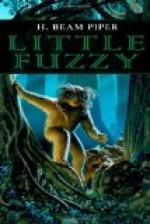There was one unusual feature; there was now a fourth man on the bench, in gold-braided Navy black; sitting a little apart from the judges, trying to look as though he weren’t there at all—Space Commodore Alex Napier.
Judge Pendarvis laid down his gavel. “Ladies and gentlemen, are you ready to present the opinions you have reached?” he asked.
Lieutenant Ybarra, the Navy psychologist, rose. There was a reading screen in front of him; he snapped it on.
“Your Honors,” he began, “there still exists considerable difference of opinion on matters of detail but we are in agreement on all major points. This is quite a lengthy report, and it has already been incorporated into the permanent record. Have I the court’s permission to summarize it?”
The court told him he had. Ybarra glanced down at the screen in front of him and continued:
“It is our opinion,” he said, “that sapience may be defined as differing from nonsapience in that it is characterized by conscious thought, by ability to think in logical sequence and by ability to think in terms other than mere sense data. We—meaning every member of every sapient race—think consciously, and we know what we are thinking. This is not to say that all our mental activity is conscious. The science of psychology is based, to a large extent, upon our realization that only a small portion of our mental activity occurs above the level of consciousness, and for centuries we have been diagraming the mind as an iceberg, one-tenth exposed and nine-tenths submerged. The art of psychiatry consists largely in bringing into consciousness some of the content of this submerged nine-tenths, and as a practitioner I can testify to its difficulty and uncertainty.
“We are so habituated to conscious thought that when we reach some conclusion by any nonconscious process, we speak of it as a ‘hunch,’ or an ‘intuition,’ and question its validity. We are so habituated to acting upon consciously formed decisions that we must laboriously acquire, by systematic drill, those automatic responses upon which we depend for survival in combat or other emergencies. And we are by nature so unaware of this vast submerged mental area that it was not until the first century Pre-Atomic that its existence was more than vaguely suspected, and its nature is still the subject of acrimonious professional disputes.”
There had been a few of those, off and on, during the past four days, too.
“If we depict sapient mentation as an iceberg, we might depict nonsapient mentation as the sunlight reflected from its surface. This is a considerably less exact analogy; while the nonsapient mind deals, consciously, with nothing but present sense data, there is a considerable absorption and re-emission of subconscious memories. Also, there are occasional flashes of what must be conscious mental activity, in dealing with some novel situation. Dr. van Riebeek, who is especially interested in the evolutionary aspect of the question, suggests that the introduction of novelty because of drastic environmental changes may have forced nonsapient beings into more or less sustained conscious thinking and so initiated mental habits which, in time, gave rise to true sapience.




